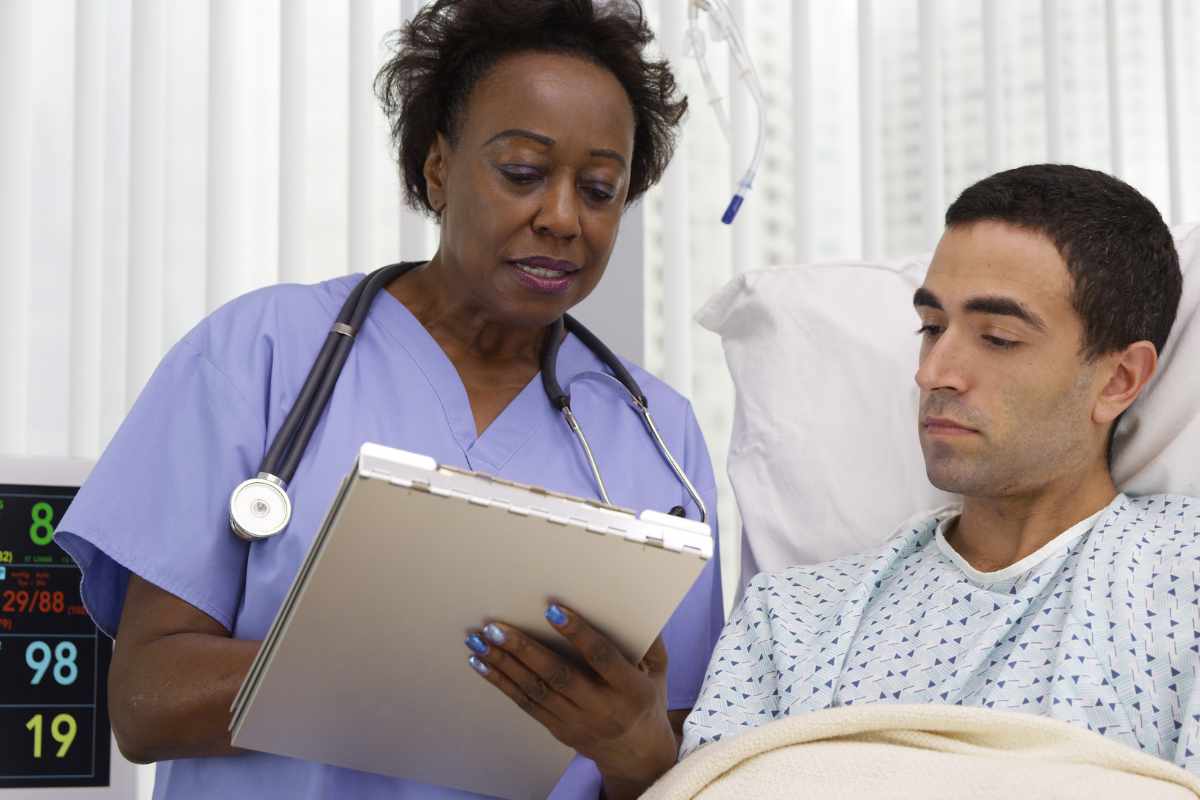How to Become a Cardiac Nurse

“I’m clear, you’re clear, airway’s clear!” a cardiac nurse says before shocking a patient’s heart with a defibrillator. Another nurse jumps in to give chest compressions, and after two minutes they both step back to evaluate the rhythm on the monitor and check the patient’s pulse.
This is an example of advanced cardiac life support (ACLS) protocols, and it’s just one of the essential skills that cardiac nurses bring to patient care. In the U.S., someone dies from cardiovascular disease every 33 seconds, and it’s the leading cause of death worldwide.
The good news is that cardiac medicine has come a long way in the past several decades, and cardiac nursing has grown more complex along with it. Medical innovations mean that many patients with advanced cardiac disease can still live long lives, and patient acuity in cardiac medicine is higher than ever.
Are you interested in cardiac physiology, and helping patients with complex health problems live better? Cardiac nursing ranks among the happiest nursing jobs and might be a great path for you. Keep reading to learn more about what it takes.
What Is a Cardiac Nurse?
Cardiac nurses specialize in caring for patients with heart and vascular problems. This includes patients with chronic cardiovascular disease, such as heart failure. Cardiac nurses also see patients who are having acute cardiovascular events, like strokes and heart attacks.
There are four categories of cardiovascular disease:
- Coronary artery disease (CAD): When the blood vessels that the heart depends on become blocked or slowed, this can lead to a heart attack (myocardial infarction).
- Cerebrovascular disease: Problems with blood flow to the brain can lead to strokes and cerebral hemorrhage.
- Peripheral artery disease: Blood vessel problems, commonly in the legs or arms, can result in low oxygen or nutrients to the affected limb.
- Aortic atherosclerosis: When the aorta — the largest artery in the body — becomes hardened or blocked and blood flow is affected, which can lead to aortic aneurysm.
These nurses must be proficient with ACLS protocols and ready to respond if a patient codes, has a stroke, or experiences another life-threatening event. A simpler version of this is basic life support (BLS), which is required to practice in most facilities.
What Does a Cardiac Nurse Do?
Exact cardiac nurse responsibilities depend on the clinical area you pursue, but typically include:
- Cardiac assessments: Cardiac nurses do full-body assessments that include pulses, breath sounds, skin temp, and more.
- Assisting with cardiac tests: Nurses gather electrocardiograms (ECGs) on patients to help clinicians diagnose rhythm abnormalities. They also assist with other cardiac tests, like echocardiograms, catheterization, stress tests, and Holter monitor exams.
- Cardiac device management: Many patients rely on devices to keep their heart and lungs functioning. Cardiac nurses need to understand how these devices work, and how to troubleshoot when something goes wrong. Cardiac devices include:
- Telemetry monitors
- Defibrillators
- Left ventricular access devices (LVADs)
- Pacemakers
- Implantable cardioverter defibrillators (ICDs)
- Intra-aortic balloon pumps (AIBPs)
- Cardiac resynchronization Therapy (CRT) devices
- Continuous positive airways pressure (CPAP) machines
- Ventilators
- Medication management: Cardiac patients are often on several medications, and nurses need to understand and be able to educate patients about their meds. Cardiac medications include beta blockers, diuretics, statins, and calcium channel blockers. In critical care units, cardiac nurses titrate medications called vasopressors to keep patients’ blood pressure and heart rate under control.
- Wound care: Cardiac patients who have come out of open heart surgery have surgical wounds that need care. Some patients might also have venous ulcers, pressure injuries, and other wounds.
- Rehabilitation: Nurses assist with cardiac rehab, where patients recover from cardiovascular events and regain functioning.
- Education: Many cardiovascular problems can be prevented with lifestyle changes. Nurses help patients understand their diagnoses and live better so their heart health can improve.
To see what else you might be responsible for, check out our sample cardiac nurse resume.
How to Enter Cardiac Nursing: 4 Steps
How long does it take to become a cardiac nurse? If you’re already a nurse, making the move to a cardiac specialty area can be fairly fast. If you’re not yet a nurse, here’s the process for becoming one and specializing in cardiac medicine.
Step 1: Nursing School
Cardiac nurse education starts with nursing school. Here you’ll develop fundamental skills, including assessments, reading ECGs, administering medications, and patient education. There are two types of nursing degrees:
- A bachelor of science in nursing (BSN) at a four-year university, which takes about four years
- An associate degree in nursing (ADN) at a technical school or community college, which takes between two and four years
Step 2: Licensure Exam
Once you’ve completed your nursing education, you’ll need to pass the National Council Licensure Examination for Registered Nurses (NCLEX-RN). This test assesses your clinical judgment and reasoning abilities, ensuring you’re prepared to provide safe and effective patient care as a registered nurse. Learn how to study for the NCLEX.
Step 3: New Graduate Residency
Once you’re a registered nurse, you’ll likely be able to enter cardiac nursing through a new graduate residency program at a medical center. Some med-surg units have a focus on cardiac patients, and larger hospitals have specialty heart units that only see patients with specific problems like heart failure or stroke. With experience, you might choose to move into critical care or outpatient cardiac medicine.
Step 4: Cardiac Nurse Certification
Once you’ve gained experience in cardiac nursing, you can advance your skills with a certification or course. These are the leading national certifications for nurses in the cardiovascular specialty:
- Cardiac Vascular Nursing Certification (CV-BC)
- Cardiovascular Nursing (CVRN-BC)
- Cardiac Medicine Certification (CMC)
- Cardiac Surgery Certification (CSC)
- Registered Cardiovascular Invasive Specialist (RCIS)
Where Do Cardiac Nurses Work?
These trained professionals can be employed in a variety of healthcare settings, including telemetry units, post-operative care, cardiovascular ICUs, outpatient clinics, and home health agencies.
If you’re interested in working with cardiac patients, some job areas to explore include:
- Telemetry nurse jobs
- ICU nurse jobs
- ER nurse jobs
- Med-surg nurse jobs
- Progressive care unit nurse jobs
How Much Does a Cardiac Nurse Make?
The average cardiac nurse salary is $76,470. These nurses can work in a variety of settings, and your pay will vary widely based on where you choose to work, certifications, education, and experience. For nurses with a specialized skill set, the job market for this role is bright. The Bureau of Labor Statistics projects a 6% increase in jobs for RNs in the next decade.
Ready to Pump Up Your Career?
Whether you’re a cardiac nurse, nurse aid, nurse practitioner, or another nursing professional, you might be wondering what your next job options are. Don’t skip a beat — get access to customized job alerts to find your next role.
